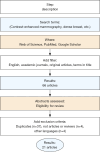Contrast-enhanced mammography in high-dense breasts: a narrative review
- PMID: 40421154
- PMCID: PMC12104952
- DOI: 10.21037/tbcr-24-64
Contrast-enhanced mammography in high-dense breasts: a narrative review
Abstract
Background and objective: Contrast-enhanced mammography (CEM) combines iodine-based contrast agents with dual-energy imaging to enhance the detection of breast cancer, especially in women with dense breast tissue. Dense breasts, which obscure conventional mammography results, present unique diagnostic challenges and an elevated risk of cancer. This review explores the role of CEM in improving diagnostic accuracy in high-density breasts, its comparative performance with other imaging modalities, and its potential implications for clinical practice.
Methods: We conducted a narrative analysis on the use of CEM in dense breast tissue by searching PubMed, Web of Science (WoS), and Google Scholar between September and November 2024. Keywords, rather than MeSH terms, were utilized to refine the search, focusing on terms appearing in article titles. Sixty-six articles were identified, and duplicates or non-eligible studies were excluded, resulting in a final selection of 21 articles published between 2013 and 2024. Additional references were identified through snowballing to contextualize findings.
Key content and findings: CEM demonstrates high sensitivity (89-97.7%) and specificity (50-89%) in detecting malignancies within dense breasts, offering comparable diagnostic accuracy to magnetic resonance imaging (MRI) but with better accessibility and lower cost. Unlike traditional mammography, CEM enhances visibility through functional imaging of contrast uptake, improving detection of small or occult lesions. It also aids in pre-surgical planning by assessing tumor size and multiplicity with greater precision. However, CEM is not without limitations, including radiation exposure and variability in equipment standards. Comparative analyses suggest CEM bridges the gap between conventional mammography and advanced techniques like MRI, particularly in resource-constrained settings.
Conclusions: CEM represents a significant advancement in breast cancer detection, addressing limitations posed by dense breast tissue. Its diagnostic accuracy, cost-effectiveness, and patient accessibility position it as a valuable tool in personalized screening strategies. Further standardization and integration into clinical workflows could expand its role in routine breast cancer management.
Keywords: Contrast-enhanced mammography (CEM); breast cancer; dense breasts; diagnostic imaging; screening.
Copyright © 2025 AME Publishing Company. All rights reserved.
Conflict of interest statement
Conflicts of Interest: All authors have completed the ICMJE uniform disclosure form (available at https://tbcr.amegroups.com/article/view/10.21037/tbcr-24-64/coif). The authors have no conflicts of interest to declare
Similar articles
-
Supplemental Screening for Breast Cancer in Women With Dense Breasts: A Systematic Review for the U.S. Preventive Service Task Force [Internet].Rockville (MD): Agency for Healthcare Research and Quality (US); 2016 Jan. Report No.: 14-05201-EF-3. Rockville (MD): Agency for Healthcare Research and Quality (US); 2016 Jan. Report No.: 14-05201-EF-3. PMID: 26866210 Free Books & Documents. Review.
-
Supplemental Screening as an Adjunct to Mammography for Breast Cancer Screening in People With Dense Breasts: A Health Technology Assessment.Ont Health Technol Assess Ser. 2023 Dec 19;23(9):1-293. eCollection 2023. Ont Health Technol Assess Ser. 2023. PMID: 39364436 Free PMC article.
-
Cancer screening with digital mammography for women at average risk for breast cancer, magnetic resonance imaging (MRI) for women at high risk: an evidence-based analysis.Ont Health Technol Assess Ser. 2010;10(3):1-55. Epub 2010 Mar 1. Ont Health Technol Assess Ser. 2010. PMID: 23074406 Free PMC article.
-
Impact of contrast-enhanced mammography in surgical management of breast cancers for women with dense breasts: a dual-center, multi-disciplinary study in Asia.Eur Radiol. 2022 Dec;32(12):8226-8237. doi: 10.1007/s00330-022-08906-0. Epub 2022 Jul 5. Eur Radiol. 2022. PMID: 35788756 Free PMC article.
-
Contrast-Enhanced Mammography versus Breast Magnetic Resonance Imaging: A Systematic Review and Meta-Analysis.Diagnostics (Basel). 2022 Aug 4;12(8):1890. doi: 10.3390/diagnostics12081890. Diagnostics (Basel). 2022. PMID: 36010240 Free PMC article. Review.
References
Publication types
LinkOut - more resources
Full Text Sources
Miscellaneous

